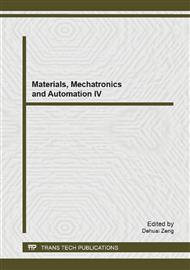[1]
B.F. Chong, L.M. Blank, R. Mclaughlin and L.K. Nielsen: Appl. Microbiol. Biotechnol., Vol. 66 (2005) No. 4, p.341.
Google Scholar
[2]
J.H. Kim, S.J. Yoo, D.K. Oh, Y.G. Kweon, D. W Park, C.H. Lee and G. H Gil: Enzyme Microb. Technol., Vol. 19 (1996) No. 6, p.440.
Google Scholar
[3]
W.Y. Chen, E. Marcellin, J. Hung and L.K. Nielsen: J. Biol. Chem., Vol. 284 (2009) No. 27, p.18007.
Google Scholar
[4]
L. Liu, G. Du, J. Chen, Y. Zhu, M. Wang and J. Sun: Bioresour. Technol., Vol. 100 (2009) No. 1, p.362.
Google Scholar
[5]
L.M. Blank, R.L. Mclaughlin and L.K. Nielsen: Biotechnol. Bioeng., Vol. 90 (2005) No. 6, p.685.
Google Scholar
[6]
X.J. Duan, L. Yang, X. Zhang and W.S. Tan: J. Microbiol. Biotechnol., Vol. 18 (2008) No. 4, p.718.
Google Scholar
[7]
L. Liu, M. Wang, G. Du and J. Chen: Lett. Appl. Microbiol., Vol. 46 (2008) No. 3, p.383.
Google Scholar
[8]
L. Liu, G. Du, J. Chen, M. Wang and J. Sun: Bioprocess Biosyst. Eng., Vol. 32 (2009) No. 6, p.755.
Google Scholar
[9]
P.H. Weigel and P.L. Deangelis: J. Biol. Chem., Vol. 282 (2007) No. 51, p.36777.
Google Scholar
[10]
S.H. Brown and P.E. Pummill: Curr. Pharm. Biotechnol., Vol. 9 (2008) No. 4, p.239.
Google Scholar
[11]
L.J. Chien and C.K. Lee: Biotechnol. Prog., Vol. 23 (2007) No. 5, p.1017.
Google Scholar
[12]
B. Widner, R. Behr, S. Von Dollen, M. Tang, T. Heu, A. Sloma, D. Sternberg, P.L. DeAngelis, P.H. Weigel and S. Brown: Appl. Environ. Microbiol., Vol. 71 (2005) No. 7, p.3747.
DOI: 10.1128/aem.71.7.3747-3752.2005
Google Scholar
[13]
L.J. Chien and C.K. Lee: Appl. Microbiol. Biotechnol., Vol. 77 (2007) No. 2, p.339.
Google Scholar
[14]
S.B. Prasad, G. Jayaraman and K.B. Ramachandran: Appl. Microbiol. Biotechnol., Vol. 86 (2010) No. 1, p.273.
Google Scholar
[15]
J.Z. Sheng, P.X. Ling, X.Q. Zhu, X.P. Guo, T.M. Zhang, Y.L. He and F.S. Wang: J. Appl. Microbiol., Vol. 107 (2009) No. 1, p.136.
Google Scholar
[16]
Z. Mao and R.R. Chen: Biotechnol. Prog., Vol. 23 (2007) No. 5, p.1038.
Google Scholar
[17]
Z. Mao, H.D. Shin and R. Chen: Appl. Microbiol. Biotechnol., Vol. 84 (2009) No. 1, p.63.
Google Scholar
[18]
H. Yu and G. Stephanopoulos: Metab. Eng., Vol. 10 (2008) No. 1, p.24.
Google Scholar
[19]
N. Izawa, T. Hanamizu, R. Iizuka, T. Sone, H. Mizukoshi, K. Kimura and K. Chiba: J. Biosci. Bioeng., Vol. 107 (2009) No. 2, p.119.
DOI: 10.1016/j.jbiosc.2008.11.007
Google Scholar


